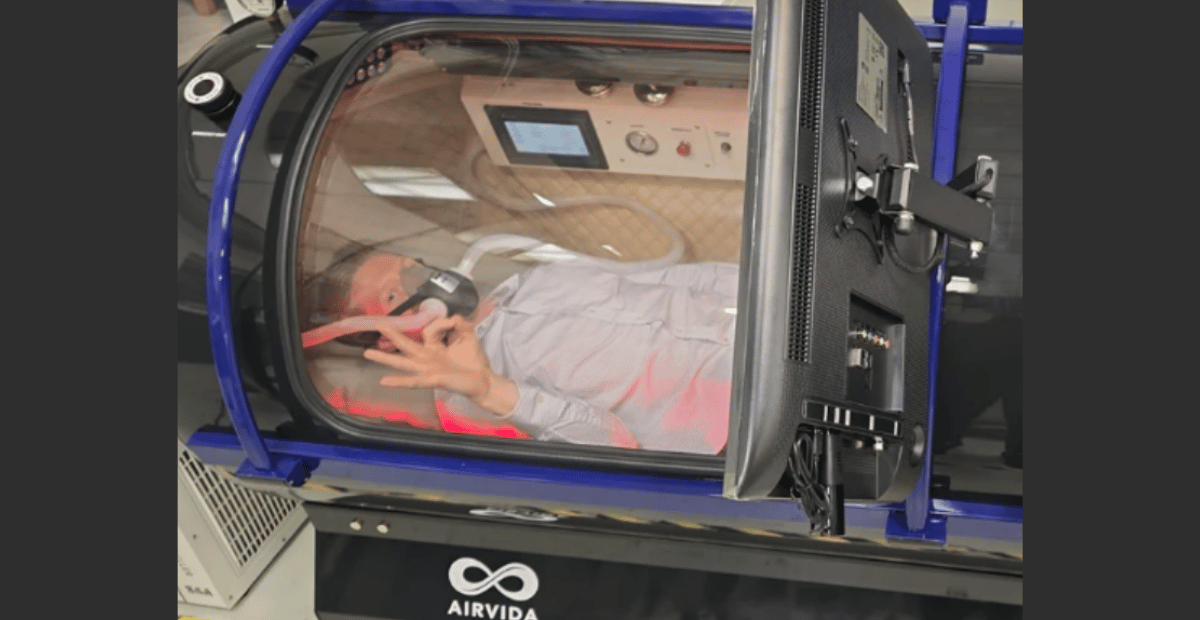A hyperbaric chamber for decompression sickness offers one of the most effective, medically proven treatments for divers and individuals exposed to rapid pressure changes. By delivering pure oxygen at increased atmospheric pressure, these chambers help the body eliminate nitrogen bubbles that can otherwise cause serious health complications.
This article will discuss how hyperbaric therapy works, why it’s considered the gold standard for decompression sickness relief, the different types of chambers available, and what to expect during treatment. Whether you’re a diver, medical professional, or simply curious about the technology, continue reading for a full breakdown of this lifesaving modality.
What Is Decompression Sickness?
Decompression sickness (DCS), also known as "the bends," occurs when dissolved gases (mainly nitrogen) come out of solution and form bubbles in the body due to rapid pressure reduction. This typically happens when a diver ascends too quickly without allowing enough time for the body to expel the gases naturally. Symptoms can range from mild joint pain to severe neurological damage or even death.
DCS doesn't only affect divers. It can also occur in aviators, astronauts, and individuals working in pressurized environments. The onset can be immediate or delayed by hours, depending on the circumstances. Early treatment is crucial, and that's where a hyperbaric chamber for decompression sickness becomes essential.
How Does a Hyperbaric Chamber Help with Decompression Sickness?

A hyperbaric chamber for decompression sickness delivers 100% oxygen at increased atmospheric pressures, typically ranging from 1.5 to 3.0 ATA (atmospheres absolute). This process forces more oxygen into the bloodstream, accelerating the reabsorption of nitrogen bubbles and reducing inflammation.
HBOT also improves blood flow, stimulates cellular repair, and enhances white blood cell activity, all critical in reversing the damage caused by DCS. Sessions usually last from 60 to 120 minutes, and the number of treatments required depends on the severity of the condition. The therapy is non-invasive and widely recognized by organizations like the U.S. Navy and Divers Alert Network (DAN).
Different Types of Hyperbaric Chambers
Hyperbaric chambers come in various forms, each designed for specific applications and pressure capacities. For optimal results, especially when treating a hyperbaric chamber for decompression sickness, higher-pressure models are essential, particularly those capable of reaching at least 1.5 ATA or more.
1. Monoplace Chambers
These single-occupant chambers are filled with pure oxygen and typically used in hospitals or clinical settings. They provide full-body exposure to high-pressure oxygen and are ideal for individualized treatment plans, including decompression sickness therapy and wound care.
2. Multiplace Chambers
Built to accommodate several people simultaneously, multiplace chambers are used in hospitals, naval bases, and commercial diving centers. They allow medical staff to enter with patients, making them suitable for emergencies or complex decompression sickness cases that require hands-on supervision.
3. Portable or Soft-Shell Chambers
Lightweight and inflatable, these chambers are designed for ease of transport and lower-pressure therapy (1.1–1.5 ATA). Though useful for altitude sickness or general wellness, they don’t meet the pressure threshold required for treating decompression sickness effectively and safely.
Featured Picks: Hard-Shell Hyperbaric Chambers for Sale
If you're looking for high-performance chambers built for therapeutic precision, a hyperbaric chamber for decompression sickness with pressures between 1.3 to 2.0 ATA is ideal, especially for applications like serious injury recovery or clinical wellness programs. Below are four standout models from Airvida Chambers, each designed to meet different needs, from private therapy to multi-user clinic operations:
1. Airvida Ultra 1.3–2.0 ATA Hard Shell Lying Hyperbaric Chamber

Built for comfort and high-capacity use, this premium lying-style chamber combines adjustable pressure up to 2.0 ATA with durable materials and medical-grade fittings. It's ideal for recovery centers, high-performance athletes, and hospitals seeking a horizontal configuration with advanced safety features.
2. Airvida Elite 1.3–2.0 ATA Hard Shell Sitting Hyperbaric Chamber

Optimized for those who prefer a seated posture, the Elite model is equipped with robust safety controls, top-tier oxygen systems, and sleek ergonomic design. Perfect for professional clinics or elder-focused care centers where sitting therapy is preferred.
3. Airvida Multiplace Hyperbaric Chamber – Phoenix 2

This commercial-grade multiplace chamber can accommodate up to two users simultaneously, making it ideal for wellness clinics or sports recovery facilities. Featuring transparent viewing windows, built-in communication systems, and a spacious interior, the Phoenix 2 elevates group HBOT to a new level.
4. Airvida Alpha 90 Hyperbaric Chamber

The Alpha 90 is a powerful hybrid design offering a semi-horizontal layout, versatile pressure settings, and a compact footprint. It strikes a perfect balance between home and clinic functionality, ideal for solo users who need top-tier performance in a smaller space.
All four chambers are engineered with safety, performance, and comfort in mind. Whether you're building a clinical-grade hyperbaric setup or upgrading your wellness facility, Airvida’s range of hard-shell chambers, including options tailored as a hyperbaric chamber for decompression sickness, delivers proven therapeutic potential at industry-leading standards.
Who Should Use a Hyperbaric Chamber for DCS?
Anyone at risk of decompression sickness, including scuba divers, saturation divers, and commercial dive operators, should have access to a hyperbaric chamber for decompression sickness. Medical professionals specializing in hyperbaric medicine also rely on these systems to deliver urgent care. Prompt access can be the difference between a full recovery and long-term damage.
Chambers should be operated by trained personnel, and patients must undergo evaluation before starting therapy. Pre-screening helps identify contraindications such as untreated pneumothorax or certain medications that may interfere with treatment.
Is It Safe? Risks and Precautions
Hyperbaric chambers are generally safe when operated according to established guidelines. However, some individuals may experience side effects such as ear discomfort, temporary vision changes, or oxygen toxicity during extended sessions. These risks are minimized by trained supervision and adherence to established treatment protocols, especially when using a hyperbaric chamber for decompression sickness.
Patients with chronic conditions like COPD, epilepsy, or cardiovascular disease should consult a physician before undergoing HBOT. Equipment should always be maintained and inspected regularly to ensure optimal safety.
Final Thoughts
Investing in the right hyperbaric chamber goes beyond choosing a machine; it’s about securing reliable, effective therapy for patients, clients, or personal recovery. Whether for clinical application, wellness optimization, or emergency preparedness, the right setup can make a significant difference in long-term outcomes.
If you're searching for a hyperbaric chamber for decompression sickness, Airvida Chambers offers durable, clinically engineered solutions designed to meet the highest standards in safety and therapeutic performance. Contact Airvida Chambers today to learn more about the models featured in this guide and discover which one is right for your needs.
Frequently Asked Questions on Hyperbaric Chamber for Decompression Sickness
What does a hyperbaric chamber do for decompression sickness?
A hyperbaric chamber treats decompression sickness by increasing atmospheric pressure and delivering 100% oxygen, which helps reduce nitrogen bubbles in the bloodstream. This accelerates their reabsorption, restores oxygen flow to tissues, and minimizes further damage. It’s the gold standard therapy for safely reversing the effects of “the bends.”
What is the difference between a hyperbaric chamber and a decompression chamber?
A hyperbaric chamber is a broader term used for various medical conditions, while a decompression chamber specifically refers to treating divers for decompression sickness. Both use increased pressure and oxygen, but decompression chambers are typically optimized for diving-related emergencies and often found in naval, marine, or diving environments.
What kind of issues does hyperbaric oxygen fix?
Hyperbaric oxygen therapy addresses decompression sickness, carbon monoxide poisoning, chronic wounds, radiation injuries, infections like gangrene, and some neurological conditions. By flooding tissues with oxygen at high pressure, it promotes faster healing, reduces swelling, combats infection, and supports regeneration in areas with limited blood or oxygen supply.
Should I breathe 100% oxygen if I have decompression sickness?
Yes, breathing 100% oxygen is critical for decompression sickness. It helps remove nitrogen from the body faster and provides tissues with the oxygen they need to heal. However, this should be done under medical supervision, ideally in a hyperbaric chamber, to ensure safety and maximum therapeutic benefit.
What happens if you ignore decompression sickness?
Ignoring decompression sickness can lead to serious complications, including permanent nerve damage, paralysis, and even death. Symptoms may worsen over time, affecting the lungs, brain, joints, or spinal cord. Immediate treatment in a hyperbaric chamber significantly improves recovery chances and minimizes the risk of long-term consequences.
You May Also Want to Read
2.0 ATA Hyperbaric Chamber for Sale: 5 Key Features to Consider Before Buying
Healing Chamber: 5 More Benefits of Hyperbaric Oxygen Chambers
Best Medical-Grade Red Light Therapy Devices: At-Home & Clinical Use
Disclaimer
Airvida and partners' advice does not constitute medical advice and is intended for informative and educational purposes only, with no medical or non-medical claims being made. While research & studies show the potential Hyperbaric Oxygen Therapy (HBOT) and Hyperbaric Air Therapy (HBAT) may have implied benefits, individual results may vary. It is required by Airvida & Partners to consult with doctors before being approved for Hyperbaric Therapy (HBOT & HBAT). Read More HERE




